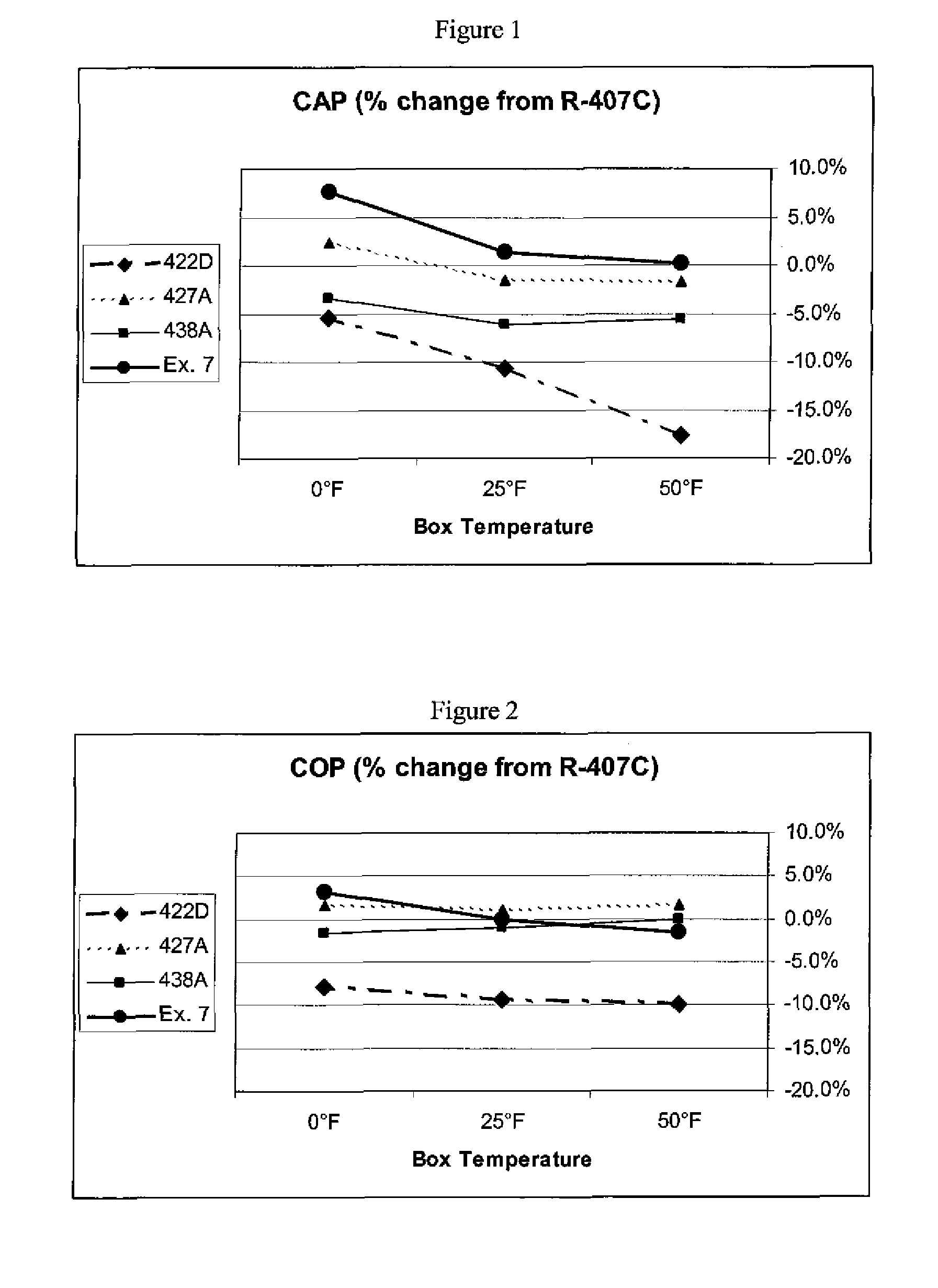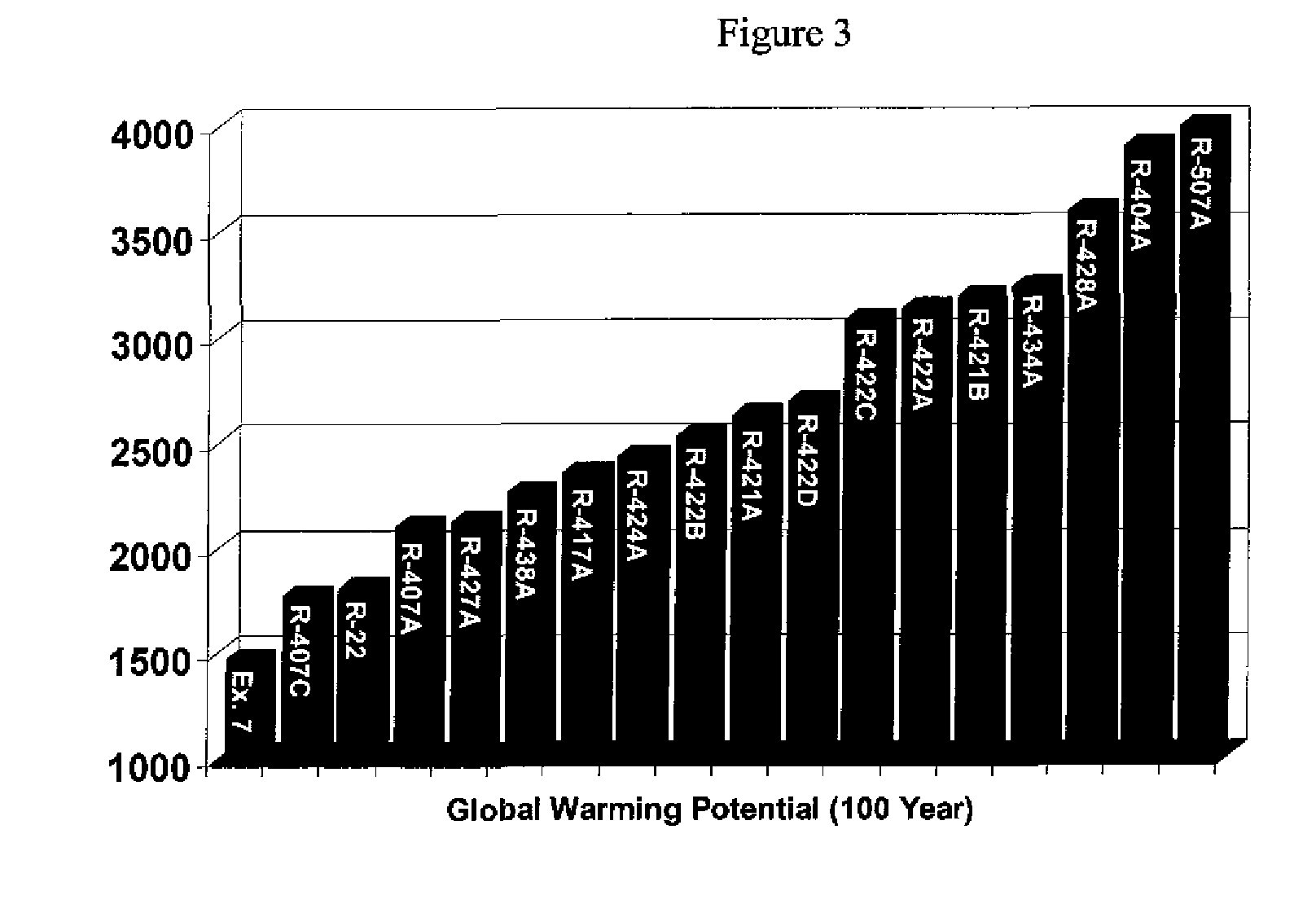Heat transfer compositions of hydrofluorocarbons and a hydrofluoroolefin
a technology of hydrofluorocarbons and compositions, which is applied in the field of heat transfer compositions, can solve the problems of compromising performance characteristics, affecting the performance of hfcs, and affecting the quality of hfcs, and can be considerably more expensive for new lubricants
- Summary
- Abstract
- Description
- Claims
- Application Information
AI Technical Summary
Benefits of technology
Problems solved by technology
Method used
Image
Examples
example 1
[0091]To a high-pressure cylinder was added a composition containing 21 wt % R-32 (difluoromethane), 25 wt % R-125 (pentafluoroethane), 22 wt % R-1234yf (2,3,3,3-tetrafluoropropene), and 32 wt % R-134a (1,1,1,2-tetrafluoroethane). Afterwards, the liquid and vapor fractions of the cylinder contents were analyzed by gas chromatography to determine the composition. The compositions are shown in Table 6; each of the compositions are either non-flammable or have very low flammability characteristics.
TABLE 6Example 1: Composition of refrigerant fractionsR-32R-125R-1234yfR-134a(wt %)(wt %)(wt %)(wt %)Overall21252232Liquid19242433Vapor31301821
EXAMPLES
Refrigeration Equipment Testing
[0092]Equipment testing was performed in a environmentally controlled facility that consists of side-by-side insulated chambers designed for the testing of air-conditioning and refrigeration equipment. Each chamber uses independent control systems to regulate temperature, humidity, and airflow to characterize the ...
example 7
[0100]The refrigeration system was operated as in Comparative Example 3 except the refrigerant was a blend of about 21% R-32, 25% R-125, 22% R-1234yf, and 32% R-134a by weight (Ex. 7). There was satisfactory oil return at all conditions. For each box temperature, the capacity, relative to R-22, and the COP are given in Table 7.
[0101]FIG. 1 shows a comparison of the CAP for R-422D, R-427A, R-438A, and Ex. 7 relative to the CAP of R-407C. The capacity of Ex. 7 was greater than that of the other R-22 replacements at all conditions tested, particularly at the lower box temperatures.
[0102]FIG. 2 shows a comparison of the COP for R-422D, R-427A, R-438A, and Ex. 7 relative to the COP of R-407C. The COP of Ex. 7 was significantly higher than that of R-422D and close to that of R-407C, R-438A, and R-427A at 25° F. and 50° F. box temperatures. At 0° F. box temperature, Ex. 7 had a greater COP than R-407C, R-427A, R-43 8A, or R-422D.
[0103]FIG. 3 shows the calculated GWP for R-22, Ex. 7, and nu...
example 8
R-22 Retrofits with Mineral Oil
[0104]Using mineral oil as the lubricant (National 150 Refrigeration Oil), the refrigeration equipment was charged with the refrigerant of Example 7, containing about 21% R-32, 25% R-125, 22% R-1234yf, and 32% R-134a. The system was operated at an ambient (condenser-side) temperature of 100° F. and a box (evaporator-side) temperature of 50° F. There was satisfactory oil return during stable operation.
[0105]The same evaluation was performed with R-422D, R-438A, and R-427A. In these cases the oil return was poor, where the oil level in the compressor dropped below OEM guidelines.
PUM
| Property | Measurement | Unit |
|---|---|---|
| wt % | aaaaa | aaaaa |
| wt % | aaaaa | aaaaa |
| wt % | aaaaa | aaaaa |
Abstract
Description
Claims
Application Information
 Login to View More
Login to View More - R&D
- Intellectual Property
- Life Sciences
- Materials
- Tech Scout
- Unparalleled Data Quality
- Higher Quality Content
- 60% Fewer Hallucinations
Browse by: Latest US Patents, China's latest patents, Technical Efficacy Thesaurus, Application Domain, Technology Topic, Popular Technical Reports.
© 2025 PatSnap. All rights reserved.Legal|Privacy policy|Modern Slavery Act Transparency Statement|Sitemap|About US| Contact US: help@patsnap.com


